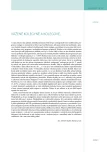Evidence based medicine
Authors:
Petr Běhounek; Milan Hora; Jiří Klečka
Authors‘ workplace:
Urologická klinika LF UK a FN, Plzeň
Published in:
Ces Urol 2011; 15(1): 10-14
Category:
Review article
Overview
EBM (evidence based medicine) is a modern direction in the international medicine. It deals with scientific evidence and its hierarchy. This system of scientific findings and their application to the clinical practice should become in future the basis for treatment of every patient. This article reveals the issue of EBM and emphasis the importance of this topic in medicine. It deals in detail with the hierarchy of evidence and thus its validity for the clinical practice. It also mentions several units which are already functional (e.g. within the evidence based guidelines) as well as some drawbacks which prevents the system EBM from implementing into routine clinical practice (e.g. insufficient systematization of evidence and subsequently insufficient accessibility for doctors). In conclusion, it emphasis the fact that EBM is the only objective way to the correct treatment of a patient.
Key words:
EBM (evidence based medicine), level of evidence, grade of recommendations, trials, metaanalysis, guidelines.
Sources
1. Greenhalgh T. Jak pracovat s vědeckou publikací: základy medicíny založené na důkazu,
1. vyd. Praha: Grada Publishing 2003; 208.
2. Sackett DL, Rosenberg WM, Gray JA, Haynes RB, Richardson WS. Evidence based medicine:
what it is and what it isn‘t. BMJ 1996; 312(7023): 71–72.
3. Donald A, Greenhalgh T. A hands-on guide to evidence based healthcare: practice and implementatio.
Oxford: Blackwell Science 2000.
4. Šmerhovský Z, Göpfertová D, Febrová J. Medicína založená na důkazech z pohledu klinického
epidemiologa. Praha: Karolinum 2007; 245.
5. Papíková V. Strategie vyhledávání a důkazy podložených informací pro potřeby klinické praxe.
Ikaros (online) 2002; 02 – dostupné na http://www.ikaros.cz/clanek.asp.
6. Guyatt GH, Haynes RB, Jaeschke RZ, Cook DJ, Green L, Naylor CD, Wilson MC,
Richardson WS. Users’ Guides to the Medical Literature: XXV. Evidence-based medicine:
principles for applying the Users’ Guides to patient care. Evidence-Based Medicine Working
Group. JAMA 2000; 284(10): 1290–1296.
7. Haynes RB. Of studies, summaries, synopses, and systems: the „4S“ evolution of services for
finding current best evidence. Evid Based Ment Health 2001; 4(2): 37–39.
8. Suchý D, Hora M, Fínek J. Vývoj a klinické hodnocení nových léčiv. Čes Urol 2009; 13(2):
141–148.
9. Rendla J. Exkurze do vědeckých lékařských informací – impakt faktor a H-index. Čes Urol
2009; 13(3): 195–199.
10. Další webové zdroje: Centre for Evidence Based Medicine (Oxford) – http://www.cebm.net/
Centre for Evidence Based Medicine – http://www.cebm.utoronto.ca/
Labels
Paediatric urologist Nephrology UrologyArticle was published in
Czech Urology

2011 Issue 1
Most read in this issue
- Evidence based medicine
- Role of a glansectomy in treatment of penile cancer
- Urological complications of pelvic fractures
- Different perspective of overactive bladder from a view of patients and urologists
